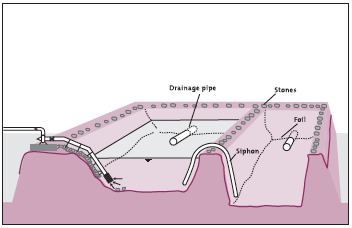Difference between revisions of "Storage / Pre-settlement"
(Created page with "Storage and sedimentation. Photo: WHO. The quality of raw water can be improved considerably by storage. During storage...") |
|||
| Line 1: | Line 1: | ||
| − | [[Image:storage and sedimentation.jpg|thumb|right|300px|Storage and sedimentation. | + | [[Image:storage and sedimentation.jpg|thumb|right|300px|Storage and sedimentation. Drawing: WHO.]] |
The quality of raw water can be improved considerably by storage. During storage, non-colloidal, suspended particles slowly settle to the bottom of a storage tank, and solar radiation will kill some of the harmful organisms in the water. Schistosoma larvae, for example, will die after storage for at least 48 hours. In contrast, colloidal particles remain in suspension. The smaller the suspended particles, the longer the water needs to be retained in the reservoir. If the suspended matter precipitates very slowly, chemicals can be added to induce coagulation and flocculation. | The quality of raw water can be improved considerably by storage. During storage, non-colloidal, suspended particles slowly settle to the bottom of a storage tank, and solar radiation will kill some of the harmful organisms in the water. Schistosoma larvae, for example, will die after storage for at least 48 hours. In contrast, colloidal particles remain in suspension. The smaller the suspended particles, the longer the water needs to be retained in the reservoir. If the suspended matter precipitates very slowly, chemicals can be added to induce coagulation and flocculation. | ||
| − | The reservoir can be constructed in several ways: | + | The reservoir can be constructed in several ways:<br> |
| − | — below ground level, with a lining of plastic sheeting to separate the stored water | + | — below ground level, with a lining of plastic sheeting to separate the stored water from the ground;<br> |
| − | from the ground; | + | — with a lining of loam, clay or concrete;<br> |
| − | — with a lining of loam, clay or concrete; | ||
— entirely from brick or concrete. | — entirely from brick or concrete. | ||
Reservoirs for sedimentation usually have two separate sections. While one is in use, the other can be cleaned. They have an intake on one side of the reservoir (or at the bottom), an outlet on the opposite side just beneath the water level, and a bottom outlet to flush the deposited material. When the water quantity or quality at the source is temporarily low, a large storage reservoir can also provide an alternative temporary source of water. | Reservoirs for sedimentation usually have two separate sections. While one is in use, the other can be cleaned. They have an intake on one side of the reservoir (or at the bottom), an outlet on the opposite side just beneath the water level, and a bottom outlet to flush the deposited material. When the water quantity or quality at the source is temporarily low, a large storage reservoir can also provide an alternative temporary source of water. | ||
Revision as of 20:07, 17 May 2012
The quality of raw water can be improved considerably by storage. During storage, non-colloidal, suspended particles slowly settle to the bottom of a storage tank, and solar radiation will kill some of the harmful organisms in the water. Schistosoma larvae, for example, will die after storage for at least 48 hours. In contrast, colloidal particles remain in suspension. The smaller the suspended particles, the longer the water needs to be retained in the reservoir. If the suspended matter precipitates very slowly, chemicals can be added to induce coagulation and flocculation.
The reservoir can be constructed in several ways:
— below ground level, with a lining of plastic sheeting to separate the stored water from the ground;
— with a lining of loam, clay or concrete;
— entirely from brick or concrete.
Reservoirs for sedimentation usually have two separate sections. While one is in use, the other can be cleaned. They have an intake on one side of the reservoir (or at the bottom), an outlet on the opposite side just beneath the water level, and a bottom outlet to flush the deposited material. When the water quantity or quality at the source is temporarily low, a large storage reservoir can also provide an alternative temporary source of water.

